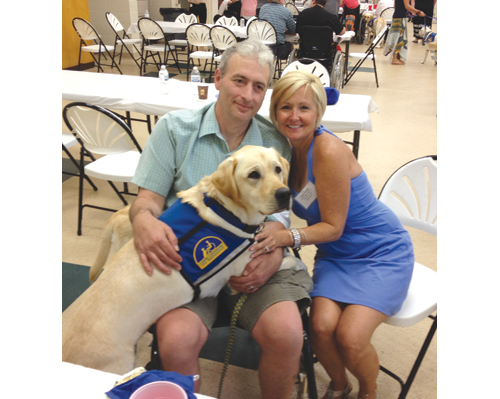Column: Raising a four-legged friend for a cause

We all bond with our pets — some of us even more so than with fellow humans — so it’s difficult to imagine ever giving them up.
But that’s what some North Fork residents — many of whom I’ve had the pleasure of knowing or at least meeting — are doing in order to train service dogs for the nonprofit Canine Companions for Independence. And with the bigger picture in mind, they find it a little easier to let go.
Canine Companions for Independence is a national organization that provides service dogs free of charge to people with various disabilities. Before the dogs go through service training, they are taken in by volunteers who acclimate them to home life and being out in public.
The Benthal family of Jamesport, who are good family friends of mine, has been actively involved with the organization. In fact, one of the children received a service dog from Canine Companions and another has raised five pups for the group
The youngest Benthal, 18-year-old Johanna, has a rare genetic neurological disease and has undergone 90 brain surgeries because of it. Seeing Johanna walk around for the past 10 years with her service dog, Taffy, has been a heart-warming, if not heart-melting, sight.
Over the years, I’ve watched as other family friends and acquaintances from the North Fork also became involved by acting as volunteer host families for Canine Companions. After witnessing the emotional connections between these volunteers and their trainees, I decided to look a little more deeply into the process.
Since 2003, 14 puppies raised on the North Fork have graduated from the program. Johanna’s older sister, MaryAngela Benthal, is currently raising her fifth service dog and Tricia Wright of Mattituck is on her fourth.
At Canine Companions, “graduated” means that the dogs have completed and passed all of the training steps in the program — a very difficult task. Only about half the dogs that enter the program end up being paired with someone in need.
The puppies are about eight weeks old when they go to the volunteers’ homes. With animals this young, MaryAngela said, the puppy-raisers focus first on the basics: acclimating them to home life, housebreaking them and introduce them to wearing a leash.
As time goes on, she said, families start teaching their canine charges basic commands. When they’re about six months old, the pups can be taken out in public and must learn to remain calm, respond to positional commands and develop other skills that prepare them for companionship with a person with disabilities.
When the puppies are 15 to 18 months old, the volunteers must turn them back over to Canine Companions so professionals can begin more extensive training.
After forming a close bond over nearly 18 months, people frequently ask MaryAngela and Tricia how they’re able to give the dogs up.
“When you see the people who are getting the dogs, they are just so deserving,” Tricia said. “Our level of need for keeping them is so far less than their level of need. You just have to do things for other people sometimes.”
“I just point next to me to Jo and say ‘That’s why,’” MaryAngela said. “I have a constant reminder of why I’m doing what I’m doing. The tangible goal is right there in my house with me.”
Ellen Torop, program manager for Canine Companions’ northeast region, based in Medford, said that after families are done training the dogs, the animals undergo a medical exam and are then evaluated based on their temperament.
“We make sure the dog isn’t fearful, isn’t too bold or isn’t too high-energy,” she explained.
The pups that make it through this round then participate in about six months of professional training, which is spent reinforcing commands they learned from their raisers and learning more advanced service-related commands and tasks like picking up objects, opening doors, turning lights on and off or pulling a wheelchair.
Applicants are paired with their dog mates during “team training,” when people who have already been accepted by Canine Companions explore which dogs they work and bond with best. MaryAngela remembers attending her sister’s session and feeling inspired by what she witnessed.
“I observed not just Jo and Taffy but other people and dogs in the class, too,” she explained. “I was amazed how all these different people came in not knowing the dogs at all and then after a few days were able to find their perfect fit for the rest of the dogs’ lives.”
After dogs and people are matched, a “graduation” ceremony takes place at which the volunteers who raised each dog return to hand the leash over to the dog’s new person.
Clay IV, the dog Tricia raised last year, just completed his training and was paired with a Canine Companions applicant during graduation last Friday.
“It was an exciting day, it really was,” she said. “And Fernando, the gentleman who received Clay, was so amazingly grateful and cheerful. You could just see how much that dog meant to him.”
Claire Leaden is a student at Manhattan College and an intern at Times/Review News Group. This is her second summer with the company. She can be reached at [email protected].


